Lynyrd Skynyrd rocking out at the Big State Festival in College Station, TX October 13, 2007.
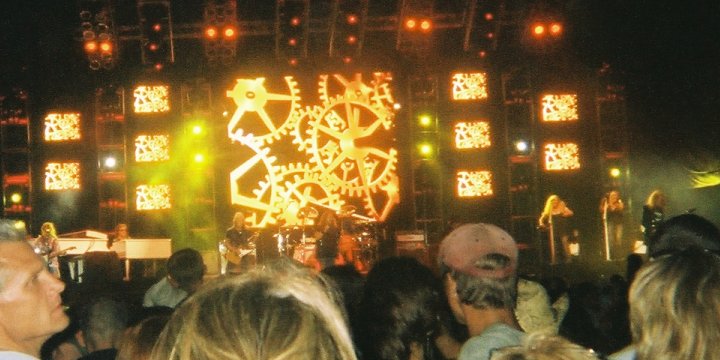
On this page: a lead example of Putting It All Together, General Comments & Suggestions, Dual Lead, Shredding, String-Skipping, Pentatonic-Arpeggios, a list of Some Songs That Have Great Guitar Solos, a list of Some Famous Guitar Players, and The Keys To Musical Success.
Guitar Lesson #15 - Dual Lead
A cool technique used by some bands is to have two leads going at the same time and having the leads harmonize with each other. Lynyrd Skynyrd and Iron Maiden achieve this effect using two lead guitarists while Brian May of Queen achieves this effect by himself by using a Digital Delay. Common relationships of the notes being played are for both guitars to play the same notes at the same time (ie, playing in unison), harmonizing by having one guitar playing notes an octave higher or lower than the other, and harmonizing by having the 1st note and 3rd note of a musical passage playing at the same time (or, to be more precise, assuming 4 beats per measure, having the notes of the 1st and 3rd beats of a measure playing at the same time), for instance:
Major scale example: 1st lead: 1, 2, 3, 4, 5, 6, 7, 1, 2, 3
2nd lead: 1, 2, 3, 4, 5, 6, 7, 1
minor scale example: 1st lead: 6, 5, 4, 3, 2, 1, 7, 6, 5, 4
2nd lead: 6, 5, 4, 3, 2, 1, 7, 6
This creates accidental interweaving counterpoint as the layered notes cross one another.
Brian May of Queen
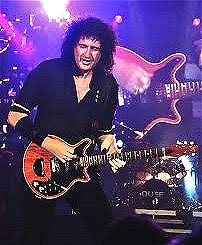
Brian May of Queen
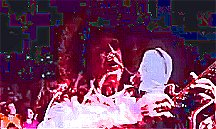
Lynyrd Skynyrd
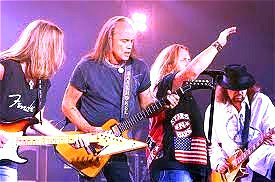
Left to right: Mark "Sparky" Matejka, Rickey Medlocke,
Johnny Van Zant, & Gary Rossington.
Lynyrd Skynyrd
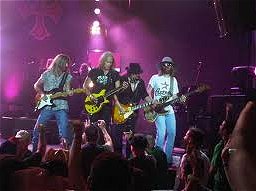
Iron Maiden
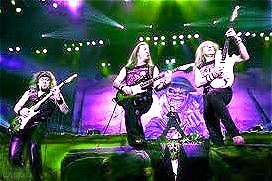
Left to right: Adrian Smith, Dave Murray, & Janick Gers
Background: lead vocals, Bruce Dickinson
Iron Maiden
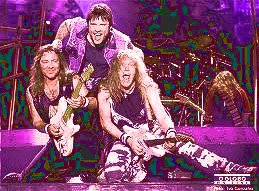
Shredding
Shredding is just a slang term for playing a guitar solo at warp speed. According to shredder-guru Michael Angelo Batio of the band "Nitro" (MetalMethod.com) one key to shredding is to use alternate picking and to hold and move your pick the same way whether you are playing fast or slow; so what you do is try just Alternate-Picking as fast as you can on just one string and observe how you are holding your pick and how you are picking; then always use that pick angle and rigidity when you are practicing or performing no matter how fast you are playing. He also stresses "Practice, practice, practice."
Another common feature of shredding is the extensive use of Arpeggios. In the shredding style, these are often played as 4-note motifs, ie, Root, 3, 5, Octave. Also, the Arpeggios are often played using Sweep-Picking where the pick is racked across the strings rather than actually picking the strings.
Shredding-guru
Michael Angelo Batio
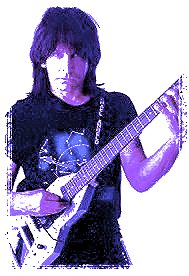
Brev Sullivan of Shred Academy
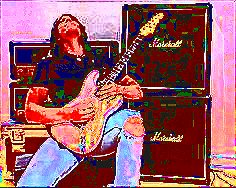
General Comments & Suggestions
You should strive to be able to use any guitar technique on any string at any position of the fretboard; then you will be able to smoothly transition from one technique to another; this is the basis for a long lead solo that doesn't become boring. Practice instills what has been called "finger memory." With practice you will find that your fingers become accustomed to the patterns and just know what to do; all you have to do is think of the general idea of the type of pattern and/or technique that you want to do and your fingers know what to do.
A professional guitar player once told me, "If you make a mistake, do it twice! Then everyone will think you did it on purpose." It sounds goofy, but it actually works pretty good.
A public musical performance is like giving a public speach, only you're memorizing sounds instead of, or in addition to, words.
All of the guitar techniques are numerically derived from the basic Number Pattern of whatever scale type you are using. Expand upon the ideas presented on this website and come up with your own unique number sequences. Experiment!
I am finding that the lighting situation is highly variable and unpredictable in live performance situations - this is one motivation for learning to play without looking at the fretboard, or at least try to minimize looking at the fretboard as much as possible; also, audiences and fans like the interaction, like to be able to see your face, or make eye contact while you're playing. Additionally, I seem to stumble onto some particularly nice-sounding riffs when I play without looking.
Intellectualize your guitar playing. Get to the point where you can practice entire songs in your head, visualizing where your fingers are on the fretboard.
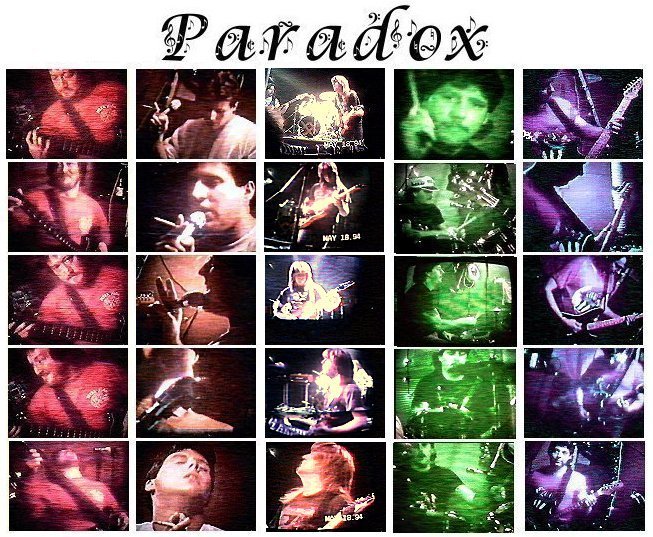
My garage band, Paradox, in 1993. From left to right:
Reggie Richardson (Bass guitar & vocals), Steve Martin (lead vocals),
Todd Hill (guitar), Ernest "Russ" Russell (drums), & myself Bob Beal (lead guitar).
Some Songs That Have Great Guitar Solos:
Back In Black - AC/DC (Angus Young)
You Shook Me All Night long - AC/DC (Angus Young)
Whole Lotta Rosie - AC/DC (Angus Young)
No More Tears - Ozzy Osbourne (Zakk Wylde)
Sold My Soul - Black Label Society (Zakk Wylde)
Heaven & Hell - Black Sabbath (Tony Iommi)
War Pigs - Black Sabbath (Tony Iommi)
Wicked World - Black Sabbath (Tony Iommi)
China Grove - Doobie Bros (Tom Johnston)
Nottingham Lace - Buckethead (Brian Carroll)
Cocaine - Eric Clapton
Crossroads - Eric Clapton & Cream
Lala - Eric Clapton
Smoke On The Water - Deep Purple (Richie Blackmore)
Rainbow In The Dark - Dio (Vivian Campbell)
Sweet Child O Mine - Guns & Roses (Slash)
Night Train - Guns & Roses (Slash)
Comfortably Numb - David Gilmour
All Along The Watchtower - Jimi Hendrix
VooDoo Child - Jimi Hendrix
The Trooper - Iron Maiden (Adrian Smith, Dave Murray, & Janick Gers)
Far Beyond The Sun - Yngwie Malmsteen
Arpeggios From Hell - Yngwie Malmsteen
Home Sweet Home - Motley Crue (Mick Mars)
Two Tickets To Paradise - Eddie Money
Stranglehold - Ted Nugent
Hellraiser - Zakk Wylde with Ozzy Osbourne
Crazy Train - Randy Rhoads
Riding The Storm Out - REO Speedwagon (Gary Richrath)
Bridge of Sighs - Robin Trower
Black Magic Woman - Carlos Santana
Oye Como Va - Carlos Santana
Samba Par Ti - Carlos Santana
Surfing With The Alien - Joe Satriani
Free Bird - Lynyrd Skynyrd
For The Love Of God - Steve Vai
Eruption - Van Halen
You Really Got Me - Van Halen
Crossfire - Stevie Ray Vaughan
Stairway To Heaven - Led Zeppelin (Jimmy Page)
LaGrange - ZZ Top (Billy Gibbons)
Hold On Loosely - 38 Special (Jeff Carlisi)
Some Famous Guitar Players:
Jimi Hendrix
Tony Iommi (Black Sabbath)
Carlos Santana
Randy Rhoads (Quiet Riot, Ozzy Osborne)
Ted Nugent
Eddie Van Halen (Van Halen)
Yngwie Malmsteen
Kirk Hammett (Metallica)
Pete Townshend (The Who)
Gary Rossington, Rickey Medlocke, & Mark "Sparky" Matejka
(Lynyrd Skynyrd)
Billy Gibbons (ZZ Top)
John Lennon, George Harrison, & Paul McCartney (The Beatles)
Jeff Beck
Eric Johnson
Dimebag Darrel (Pantera)
Angus Young (AC/DC)
David Gilmore (Pink Floyd)
Slash (Guns & Roses)
Zakk Wylde (Black Label Society, Ozzy Osbourne)
Gus G., aka Kostas Karamitroudis (Ozzy Osbourne, Firewind, & others)
Jeff Watson & Brad Gillis (Night Ranger)
Gary Richrath (REO Speedwagon)
Joe Walsh (The Eagles)
Mick Mars (Motley Crue)
Pete Willis, Phil Collen, & Steve Clark (Def Leppard)
Vivian Campbell (Dio, Whitesnake, Def Leppard)
Mike Campbell (Tom Petty and the Heartbreakers)
Phil Campbell (Motorhead)
George Lynch (Dokken)
Neal Schon (Journey)
Glen Buxton (Alice Cooper)
Richie Blackmore (Deep Purple)
Steve Morse (Deep Purple since 1994)
Stevie Ray Vaughan
Jimmy Page (Led Zeppelin)
Joe Satriani
Steve Vai
Paul Stanley & Ace Frehley (Kiss)
Eric Clapton
BB King
Glen Tipton & KK Downing (Judas Priest)
Dave Murray, Adrian Smith, & Janick Gers (Iron Maiden)
Richie Sambora (Bon Jovi)
Jake E. Lee (Ozzy Osbourne)
Brian May (Queen)
Scott Ian (Anthrax)
Kerry King (Slayer)
Chad Kroeger (Nickelback)
Dave Mustaine & Glen Dover (Megadeth)
Jeff Hanneman & Kerry King (Slayer)
Vernon Reid (Living Color)
Robin Trower
Frank Zappa
Rik Emmett (Triumph)
Steve Lukather (Toto)
Carlos Cavazo (Quiet Riot)
Joe Perry (Aerosmith)
John Fogerty (Creedence Clearwater Revival)
Nancy Wilson (Heart)
Charo (flamenco guitarist)
Esteban
Wolf Hoffmann & Jörg Fischer (Accept)
Paul Gilbert (Racer X, Mr. Big)
Vinnie Moore (UFO)
C.C. Deville (Poison)
Ash Soular
Orianthi
Joan Jett
Lita Ford
Brody Dalle (The Distillers, Spinnerette)
Jennifer Batten (guitarist for Michael Jackson)
Marnie Stern
Miki Berenyi (Lush)
The Great Kat
Ruyter Suys (Nashville Pussy)
Alison Robertson (Nashville Pussy)
Reb Beach (Whitesnake, Winger, Dokken)
Doug Aldrich (Whitesnake, Dio)
Jonathan Geange (Newsboys)
John Frusciante (The Red Hot Chili Peppers)
John Petrucci (Dream Theater)
Michael Angelo Batio (Nitro)
Lead Guitar - Intellect and Emotion -
The Keys To Musical Success
By Robert M Beal
A lead guitarist in these modern times is expected to be proficient at a lot of guitar playing techniques, be capable of playing ultra-fast (shred), and have a basic understanding of Music Theory. The advanced lead guitarist must know the Church Modes and "modal" playing, know what a Natural minor and a Natural Major scale is, know about all the other "modes," the Church Modes: Ionian, Dorian, Phrygian, Lydian, Mixolydian, Aeolian, and Locrian; he or she must be able to play crisp staccato using Alternate-Picking or smooth and flowing legato using Hammer-Ons and Pull-Offs; the virtuoso knows Sequencing (what my guitar teacher called "Digital-Picking"), and Pedal-Point, and understand these ideas well enough to extend them and make up original Sequences; you've got to be able to play Arpeggios like Ingwie Malmsteen, Trills like Tony Iommi, Octaves like Jimi Hendrix, and Finger-Tap like Eddie Van Halen; you've got to know about Double-Stops, Neighbor Tones, and be good at String-Bending and Vibrato; you've got to know the Church Modes, The Pentatonic Scale, The Augmented, Diminished, and Chromatic Scales, and The Harmonic Minor Scale over the entire fretboard; and you've got to be able to mix and connect all of these things and move from technique to technique to technique in a musical, flowing manner; and then, just when you thought you knew it all, there's the rather obscure, elusive concepts of Melody and Emotion.
Melody adds emotion to your playing. The first Melody concept is that of tension and resolution. Ascending riffs generally create tension which is resolved or released with a descending riff. Another similar Melody concept is that of "Call and Response." A lead part can be split into two musical phrases where the first phrase, the "Call," sort of asks a question, which is resolved, or answered, by the second phrase, the "Response." Listen to the first few measures of Foghat's "I Just Want To Make Love To You," for an example of Call and Response.
A Key to making a lead part emotionally moving is that you have to make it sing. The lead part has to literally sing. BB King's playing style is an example of this; you will notice something that he does is he will sing along with what he's playing, and the guitar will be hitting the exact same notes that he's singing. A similar example is Peter Frampton, famous for playing through a talk-box. A third example is the playing style of Carlos Santana; even though he's strictly adhering to well defined-scales, his guitar seems to be singing to you. For more examples of emotional guitar playing, listen to Robin Trower's "Bridge of Sighs" or David Gilmore's solo in Pink Floyd's "Comfortably Numb." The guitar acts as a voice. The guitar literally sings. In your mind, as you play lead, think of words, lyrics, or just the pure emotion of what the lead part is trying to express, and have your guitar find matching tones. In this way you can break away from strictly scale-based playing and enter the world of Melody and Emotion.
Some other ways to add Emotion is through string-bending, vibrato, controlling how soft or hard you play, i.e., controlling the string "attack," and varying the softness or loudness of the song, i.e., the "song dynamics." Guitar Effects Pedals can also help with Emotion - Distortion for that powerful rock growl, Phasers and Flangers for a mystical atmosphere, reverb and Digital Delay for concert hall simulation.
Two ways you can add Melody to your lead Technique are sequentially or simultaneously. Combining sequentially, you can do a little of one and then the other; play a fast, flashy, technical riff, then fall into a slower, more emotional line. Combining simultaneously, you play your guitar techniques while at the same time being sure to add lots of feeling and emotion as does Carlos Santana.
So here it is: The Keys to musical success, The Secret that will unlock your true musical potential, the profound breakthrough concept that could make you a star and that you will never, ever forget - there are two primary aspects to playing guitar solos and music in general; they are Intellect and Emotion. In all things, there is a Masculine side and a Feminine side, Yin and Yang, or Intellect and Emotion. In lead guitar, The Techniques embodies the Masculine Side, the Yang, the scientific, intellectual, technical side of playing which involves gaining knowledge, understanding, and competence in all of the Scales and the guitar playing techniques mentioned above: Hammer-Ons, Pull-Offs, Sequencing, Pedal-Point, Arpeggios, Finger-Tapping, etc; The Feminine Side, The Yin, side of playing lead is The Emotion created through Melody, String Attack, Vibrato, String-Bending, Song Dynamics, & Effects Pedals. Emotion breathes life into your lead. In the same way that it takes both a man and a woman to create life, a lead guitar solo requires both aspects - Intellect and Emotion - to come to life. You can be the fastest, most amazing technical shredder in the world, but what will people remember of your performance? They will have a vague sense that you were incredibly fast and an excellent guitar player, but nothing specific of the thousands of notes you've played. On the other hand, do you know, "Home, Home On The Range?" How about, "Twinkle, Twinkle, Little Star?" Why? Because they both have an emotionally memorable Melody line. An outstanding lead includes both Techniques and Emotion; it is a blending of Science and Art, Intellect & Emotion. Bob Beal http://www.LeadGuitarWorkshop.ws/

Return to Top of this page.
Putting It All Together
This next audio example demonstrates creating a long lead solo
(i.e. "jamming") utilizing many of the techniques discussed:
String-Skipping
A technique used by Eric Johnson is "String-Skipping" - you play a note, then the next note you pluck is not on the same string or an adjacent string, so you're reaching across strings to get that second note. The second note then is typically somewhere in the 2nd octave above the first note - these wide intervals lets you use notes that otherwise wouldn't sound very good such as a Root - b2 or a Root - #5, but because its in the 2nd octave, it sounds musical and just creates an interesting tension.
"Pentatonic Arpeggios"
Typically you just play one note per string doing arpeggios. It occurred to me that you could do the same with the Pentatonic Scale Patterns. I find that I really like the way these sound - its similar to arpeggios, but not as predictable. It also sounds similar to some Eric Johnson riffs. In this next graphic you play either just the red notes OR just the black notes, one note per string like an arpeggio: String-Skipping and Pentatonic-Arpeggio Example: Audio Examples of Dual-Lead using a Delay Box: Some original songs:
Bob Beal - guitar and vocals
Alyssa Perez - vocals
Sue “Lovie” Lovelace - Bass
John Lovelace - Drums "Come Along With Me"
(Phrygian Mode) |
|
|